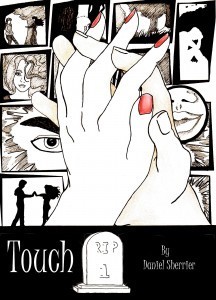Daniel Sherrier's Blog, page 49
July 20, 2014
Excerpt time! Sci-fi goodness from the upcoming Earths in Space: We Must Evolve…
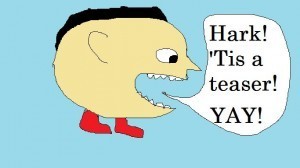 Work progresses on Earths in Space vol. 2: We Must Evolve. Trusty beta readers are going through it right now and have begun providing great feedback to help me bring it to the next level.
Work progresses on Earths in Space vol. 2: We Must Evolve. Trusty beta readers are going through it right now and have begun providing great feedback to help me bring it to the next level.
The book is already taking the Earths in Space series to the next level, with (currently) 116,000+ words of sci-fi adventure — a cross between Star Trek and Doctor Who, with a team dynamic along the lines of The Avengers.
The first volume is a fun romp. This one should turn out far superior in every way. We could say it’s evolving…
For now, here’s a work-in-progress excerpt:
Copyright 2014 Daniel R. Sherrier
*****
Sela shut off her gadget. The paneling sprang to life, dragged her through the hull, and it dropped her into a dimly lit corridor. Tall glass cases lined both walls, stopping just before a bulky door a short walk away, though they took a couple of breaks to permit alcoves on both sides. Condensation obscured their contents.
She rubbed her forearm against the nearest case, wiping away the moisture until she could see a woman sleeping within. The individual stood perfectly still behind the glass, not even breathing. A faint coat of blue covered her exposed skin, though it appeared purplish through Sela’s helmet. There was glass within the glass, specifically around her head—a fishbowl helmet above which stringy cables bunched together. They extended down, spreading out onto various points of her skin and through her clothing, as well as into the fishbowl helmet.
The case re-frosted, but Sela was already directing her attention upward. She followed the cables into a compact generator that sat upon the case, forming its cap. Straining, her ears detected a soft hum, and she realized even that little bit of noise was cumulative. The dozens of generators produced a handful of decibels. Each unit was plugged into the wall, which, Sela presumed, allowed them to draw power from the exterior solar paneling.
How long had this technology kept these people alive? The computers positioned at the bottom of each case displayed the answer. Sela stood straighter and nodded in respect.
A cough came from nowhere, startling Sela, yanking her away from burgeoning ideas on cryogenics.
No, not nowhere—the alcove. She approached tentatively.
“It’s the most beautiful thing I’ve ever seen,” a man said. He cleared his throat before continuing. “It’s so clean and pure.”
Sela peered around the corner and found the lone man gazing out a hexagonal window as the bright whiteness of Pluto reflected back on him. What appeared to be an oxygen tank was strapped to his back, plugged into his rotund helmet. Sela glanced at the air quality scanner on her wrist, and it reported safe, breathable air. This ark replicated Earth’s sea-level atmosphere even more accurately than her own vessel. She decided not to lower her helmet yet.
The man turned to her. The glass failed to dull the curiosity in his eyes. Despite his rumpled attire, emaciated physique, and general air of weariness, he seemed compelling. Sela knew this was a smart man.
“What do you think?” he asked.
“That’s something of a loaded question with me. I never know where to begin. I have so many questions, the most pertinent of which has to do with my colleagues.”
“They’re still them. If they didn’t arrive here, they must be with one of the other greeters. I’m supposed to greet you. Hello.”
“Hi. I’m Sela.”
The man looked up at nothing in particular, rediscovering a concept. “Right. I guess you need something to call me. Fabrice.”
“Nice to meet you, Fabrice. This ship is a marvel. The solar capture technology must be incredible—I mean, factoring in the considerable time you must have spent in-between solar systems subsisting off of ambient solar radiation. Granted, the momentum must have carried much of the workload, and life support is hardly a necessary expenditure for a trip spent in suspended animation. Still…” She pointed at the nearest cryogenic tank and its computer. “Am I reading that right? You left your Earth forty-thousand years ago?”
Fabrice turned to Pluto. “Forty-thousand years, and here we are, just as we were.”
“Your technology could revolutionize the energy industry. The key to perpetual power is right here in your infrastructure.” The idea sparked a new one. “It might be possible to recycle the sun.” It made sense to her, and it led to further ideas.
She contemplated how this technology might facilitate a lunar colony, though she kept interrupting herself with notions of stellar recycling. Doubts arose, but a robust internal debate thwarted most of them. That didn’t stop new doubts from emerging. Those doubts needed to wait, however, as she considered how this ancient technology might integrate with the octahedron’s systems. She vigorously tapped her helmet and kept tilting her head at various angles in hopes of acquiring a better perspective of each new hypothetical scenario.
Fabrice watched her brainstorm, and Sela became self-conscious. Her mind was behaving inappropriately. Too many other questions required more immediate answers.
“Thank you, Sela,” he said, his mouth lifting into a slight smile for the first time. “It is my technology. The solar capture, the cryogenics, your route of ingress—my ideas.”
He truly did seem compelling, Sela thought, and his voice acquired a seductive quality. The temperature rose within her climate-controlled spacesuit.
“I’d love to exchange ideas sometime,” she said. “I’ve developed a means of trans-spatial travel—‘popping’—I refer to it as ‘popping’ across the galaxy. Just a silly little term. I surrendered to a moment of whimsy. Of course, with the power required to achieve the speeds necessary to cut out of normal space entirely and reappear at a predetermined point, the vessel has to remain relatively small, at least as far as I’ve managed to figure out. Nothing of this scale. But if we incorporated your solar capture units, perhaps if they stockpiled the requisite energy…”
Too many unanswered questions, she reminded herself. Stop adding new ones.
Fabrice said, “I like your helmet. And your belt. Are those devices of your own invention?”
“Oh. Yes.” Sela looked down at her gadgets and felt oddly embarrassed as a few knocked against each other. “Most are just cheap parlor tricks, really.”
Unanswered questions!
“Why are you here? We don’t mind, necessarily,” she said, as her brain continued jumping tracks. “And then there’s the matter of the lifesigns my colleague detected on Pluto, and my sensor’s picking up clean air here, and yet you’re breathing your own oxygen supply. And the impetus for embarking on a forty-thousand-year journey—I assume Pluto wasn’t your target?”
“It was not. It was an unanticipated variable.”
“I thought so. So you were coming to us. You’ve been coming to us since long before we had a civilization.” She wanted to take a step forward, but something held her back. “What happened to your world?”
Fabrice extended an arm toward the cryogenic tanks, the ones to the right. “You can probably see for yourself by now.”
Sela hurried back into the corridor and inspected the tanks. Most looked the same, except the one with a puddle forming at its base. She sprinted over there and wiped away the condensation, but it didn’t clear up. Moisture accumulated inside as well. The computer screen flashed red.
“Fabrice! This person is thawing. How do we fix it?”
“On my world, we have—we had a theory of cosmic entropy. Systems strive for homogeneity.”
“Whoever is in that tank is going to die if we don’t do something.”
“The entire universe is constantly struggling to reach a uniform temperature. It craves sameness.”
Sela dropped onto her knees in front of the computer. Maybe she could learn the system fast enough to save the poor soul.
Fabrice continued, his tone losing any charm it once had, if it ever had any. “A universe craving homogeneity has an obstacle, a nemesis—life. We’re the piece that doesn’t belong. The universe wants us to perish.”
The figure behind the fogged glass stirred.
“He’s still alive, Fabrice. How do we get him out of—”
The case shattered, and shards bounced off Sela’s helmet as she fell onto her back, damaging some of her equipment. A bright purplish orb forced her to shield her eyes, though it was almost certainly bluish to naked perception. The glare effectively blinded her while her pupils went about the tedious chore of adjusting. Her curiosity, however, proved stronger than her discomfort. She squinted through her fingers, into the glare, and her eyes snapped wide open.
The man exited the tank for the first time in forty-thousand years, his fists leading the way. His legs didn’t do much of anything, didn’t need to.
That bright purplish orb was the man’s head. And the man was floating.
Floating toward her.
He descended, his legs bending in whatever direction would get them out of the way. His fists uncurled, and he pawed at Sela’s helmet until he found purchase.
She reached for her lighter. Her arm quavered as she fired at his midsection. She could have sworn the laser struck him, but he displayed no reaction and his hands remained on her helmet. He didn’t attack her, just held on with such strength that she couldn’t slip away.
Coherence melted away from her thoughts, so she tried to latch onto whatever ones she could. That man, the non-glowing man, whatever his name was, he was talking about, about, about entropy. Focus on entropy. Entropy. What about entropy? Entropy was…was…
…
*****
You’ll be able to find out what happens next within a few months or so.
In the meantime, don’t forget to check out the first volume, Where Are the Little Green Men?, if you haven’t already. A huge thank you to everyone who has!
July 10, 2014
Veronica Mars lives on…in books
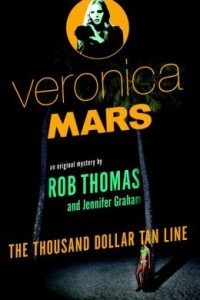 I’ve got a new post up at Smash Cut Culture, and it’s all about Veronica Mars‘ transition into a novel series…plus a quick comparison to Buffy‘s transition into comic books.
I’ve got a new post up at Smash Cut Culture, and it’s all about Veronica Mars‘ transition into a novel series…plus a quick comparison to Buffy‘s transition into comic books.
Check it out, please, along with the other writers’ pop culture commentary on this new site.
(Spoiler: Yes, fans should read this book. I’ll be sure to pick up the next installment.)
In other news, Smashwords has a sale going on this month. Lots of e-books are 25 percent to 100 percent off (yes — free e-books!) with coupon codes. Both RIP: Choices After Death and Earths in Space: Where Are the Little Green Men? can be yours at half the cost with promo code SSW50 at Smashwords only.
Probably a good day to check out Smashwords. And a good day to look at Smash Cut Culture.
Anything with “smash,” I guess. Oh, just go and pick up an Incredible Hulk comic while you’re at it.
June 29, 2014
What’s in the box?
A box full of escapist sci-fi fun arrived at my door the other day, but it seems to contain a bunch of duplicates.
Guess I’ll just have to sell them at the Hanover Book Festival on Aug. 9.
June 22, 2014
The forgotten origin of Smurfette
I smurfed across a piece of pop culture trivia while babysitting my niece last night.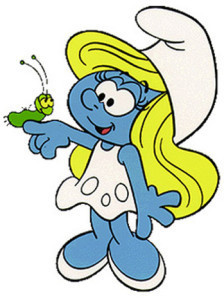
After playing with my old Smurfs figurines for a while, she wanted to see an actual Smurfs cartoon. So I went to YouTube and searched “Smurfs.”
One of the first results was an episode titled “The Smurfette,” labeled as “S01E01” (though IMDB.com says it’s the 21st episode, which came out in 1981).
Turns out, Smurfette was not a naturally born Smurf, nor was she a natural blonde.
Smurfette was a creation of Gargamel. He intended this black-haired girl Smurf to infiltrate the all-male Smurfs and spy on them.
And indeed, she caused some trouble, at least until Papa Smurf cast a spell to make her more like a “real” Smurf. This colored her hair yellow, because good Smurf girls have yellow hair and bad Smurf girls have black hair. I guess. But to become a really real Smurf, Smurfette needed to do something truly smurfy.
She saved the boys from the clutches of Gargamel, and that did the trick. Yay! Smurfette has smurfed into a true Smurf.
So if you, like me, have wondered why Smurfette was the only female Smurf in all the land, there’s your answer. Female Smurfs are unnaturally created from evil wizards.
Smurf. That’s all I can say about that bit of early ’80s sexism. Just smurf.
But at least she saved the day in the end. That’s got to count for something, right?
Smurf if for yourself:
June 12, 2014
I missed having Jon Stewart as my commencement speaker by one year
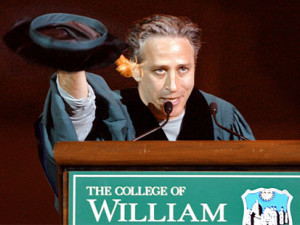 Graduation season has reminded me of something:
Graduation season has reminded me of something:
I was one year off from having Jon Stewart has my college commencement speaker.
The host of Comedy Central’s The Daily Show is a fellow William & Mary grad, about 20 or so years ahead of me, and he delivered the 2004 commencement address. I graduated in 2005.
We juniors were a bit frustrated.
Granted, some of us did get to see him the fall of our sophomore year, when he gave a free Q&A at William & Mary Hall as part of that year’s Homecoming festivities. That was fun. I remember him alienating half his audience by going off on an anti-fraternity and sorority tangent.
“I am not your brother,” he told members of the frat he used to belong to, before later back-pedaling just a bit to assure everyone that Greek life does have some positive benefits. That might have eased some of the distraught looks he was receiving from his fans.
He would’ve been one heck of an entertaining commencement speaker. I’m not even one of his bigger fan.
I gave up on The Daily Show after the studio audience kept annoying me by cheering any criticisms of Republicans, like politics were some kind of sporting event or a contest between good and evil. As someone who’s generally misanthropic when it comes to federal-level politics, I prefer more balance in my political satire.
But Stewart’s a funny, smart guy. From the transcript I read and from what I heard, he gave an excellent speech to my slightly-elders.
So what was in store for the Class of 2005? How do you top a famous comedian for a commencement speaker?
Apparently, you don’t even try.
Our commencement speaker was none other than W&M President Timothy J. Sullivan.
The man we had seen for the past four years was our special “guest” speaker at graduation.
Sullivan was retiring that year, and he was certainly a well-liked president—a good guy all around, as far as I could tell.
But still, while other colleges and universities brought in all sorts of dignitaries with interesting backgrounds to impart precious wisdom to our peers across the country, we got to listen to the same man we’d been listening to all along—one year after Jon “The Daily Show” Stewart.
All I remember of Sullivan’s speech is when he welcomed us into the ranks of “educated people,” thereby inadvertently insulting all the adult relatives in the audience who didn’t have their bachelor’s degrees.
I suppose if you keep talking long enough, you’re bound to insult someone sooner or later.
Maybe I should keep my books short.
Oh, wait. The second Earths in Space is clocking in at 115,000+ words. Oops. Guess I’ll just have to insult someone.
June 1, 2014
X-Men: Days of Future Past, the comic book — a look back
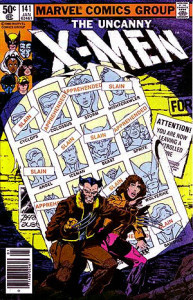 Lots of people are enjoying the latest installment of the X-Men film franchise, Days of Future Past. Rotten Tomatoes has it at 92 percent fresh among critics, and 95 percent of RT users have given it their seal of approval.
Lots of people are enjoying the latest installment of the X-Men film franchise, Days of Future Past. Rotten Tomatoes has it at 92 percent fresh among critics, and 95 percent of RT users have given it their seal of approval.
Most X-Men comics fans are familiar with—and love—the original Days of Future Past storyline that appeared in Uncanny X-Men #141 and #142 in 1980. For the rest of you, I’ll provide the retrospective and a glimpse at some X-history. Spoilers ahead for the comic book; movie spoilers won’t exceed what you see in promotional materials.
The comics storyline came out at the end of the collaboration between writer Chris Claremont and artist John Byrne. These two are largely responsible for the X-Men becoming such a popular property.
The original run by series creators Stan Lee and Jack Kirby in the 1960s was never anywhere near as successful as Spider-Man or the Fantastic Four. The series went on for 60-some issues with various writers and artists before regressing to a string of reprints of earlier issues. The series succumbed to cancellation, and Professor X, Cyclops, Beast, Iceman, Angel, and Marvel Girl (Jean Grey) spent the early 1970s in a sort of Marvel limbo. Readers might find them in guest appearances, and there was even an attempt to spin Hank McCoy/The Beast off into a solo series piloted in an anthology called Amazing Adventures. (That’s when he became blue and furry for the first time, which he brought on himself, in the spirit of what we see in the movie First Class.) That lasted maybe eight or so issues, but Beast then found a home as a member of The Avengers—where he still was at the time of Days of Future Past.
The X-Men were revived in Giant Size X-Men #1 in 1975 with a mostly new and multi-cultural group—also a more adult group compared to the teenagers of the 1960s series. X-Men resumed with #94 shortly later. Claremont took over full writing duties soon, and Byrne joined him in #108.
Shortly before Days of Future Past, they gave use another classic storyline, The Dark Phoenix Saga, which resulted in the death of Jean Grey. Cyclops quit the team after that, and leadership duties fell to Storm. In fact, DOFP is her first mission as team leader and sets the tone for how she would lead in many, many adventures to come. The rest of the “present-day” team consists of Wolverine, Nightcrawler, Colossus, Angel, and newcomer Kitty Pryde, all under the guidance of Professor X.
Kitty is all of 13 years old and still acclimating to life at Xavier’s. Nightcrawler’s inhuman appearance still unsettles her, and honestly she could be kind of annoying in those early days. (Though she’s since grown up into one of the best X-characters.) She’s never exhibited time-travel powers in the comics, by the way, but we’ll get to that.
Angel is the winged guy we saw in X-Men: The Last Stand, not the young woman we saw in First Class. He was a member of the original X-Men and had just returned, and he’s rather rusty.
Wolverine here is considerably more psychotic than Hugh Jackman’s current portrayal. At one point, he’s ready to impale a bad guy with his claws, and Storm goes out of her way to stop him and issue a stern warning that he will not slay anyone on her watch. It’s a nice little mid-battle moment giving us our first glimpse that Storm has true leadership potential.
The storyline opens in 2013 (yes, this all happened last year, or would have had the X-Men altered the timeline, obviously). The future X-Men are an adult Kate Pryde, Wolverine, Storm, Colossus, a new telepathic character named Rachel, a wheelchair-bound Magneto, and Franklin Richards, son of Reed and Sue Richards of the late Fantastic Four. In this dystopian future, the robotic Sentinels have taken control and have rounded up mutants in camps and fitted them with inhibitor collars to shut off their powers.
The bad times can be traced back to when a mutant assassinated U.S. Senator Kelly, so the X-Men hatch a plan to elude the effects of the inhibitor collar and use Rachel’s mental powers to send Kate/Kitty’s mind back to her 13-year-old body, at a time before she had been trained to shield herself from any mental attacks.
That’s why Kitty was chosen as the time-traveler—she was the novice. In the movie, they need to send someone back to 1973, before Kitty was born, so the writers took liberties with her phasing powers and added “passing people through time” to her usual skill “of passing through solid objects.” Probably better than coming up with some convoluted method of time-travel. And it lets Hugh Jackman be the star.
On a creepy note, in the comic, future Kitty and Colossus are in a relationship. In the present, Kitty is 13 and Colossus is about 19 or so. Ew.
Once “Kate” arrives in Kitty’s younger body, she warns the X-Men of the threat to the senator’s life. They’re skeptical, but they can’t risk not taking it seriously. Professor X, coincidentally, and friend Moira McTaggart are at a congressional hearing where Sen. Kelly is going off about the “mutant menace.”
So the X-Men go to Washington.
Meanwhile, Mystique makes her first appearance in the X-Men comics. She had debuted as a 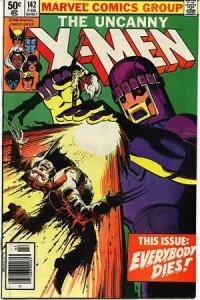 nemesis for Ms. Marvel (a non-mutant super-hero and Avenger who today is experiencing a surge of popularity among comics fans as Captain Marvel).
nemesis for Ms. Marvel (a non-mutant super-hero and Avenger who today is experiencing a surge of popularity among comics fans as Captain Marvel).
Mystique has just assembled a new Brotherhood of Evil Mutants (let’s assume the characters are using “evil” ironically) consisting of the Blob, Pyro, Avalanche, and the precognitive Destiny.
At this point, comics Mystique has no personal ties to Charles Xavier or Magneto. She’s a shape-shifter who has wormed her way into the Pentagon as Raven Darkholme. In DOFP, there are hints that she has personal ties to Nightcrawler, and we later learn she’s his biological mother who had abandoned him at birth. Additionally, Mystique is the foster mother of Rogue, who is about a year away from her comics introduction at the time of DOFP. (Rogue debuted in The Avengers as the bad guy who stripped Ms. Marvel of her powers and memories, by the way.)
Also of note, Prof. X and Magneto didn’t even have any personal history at this point in the comics. Their past friendship was retroactively inserted into continuity about 20 issues later.
The bulk of the present-day storyline is the X-Men vs. the Brotherhood in a big brawl in DC. Pretty basic stuff, but fun. It’s mostly notable, again, for Storm’s leadership debut and Mystique’s introduction to the X-Men comics.
The future scenes were more groundbreaking at the time, as we see our favorite characters in a world in which they’ve failed and don’t have much else to lose. And we see them die. Sure, Phoenix’s death was only a handful of issues beforehand, and that was actually our present-day Jean Grey, so that was a huge deal, but this is basically The End of the X-Men—a true “last stand” in a future that seems not terribly far-fetched within the Marvel Universe.
It’s pretty dark at a time when comics were regarded as kids’ stuff (and indeed, most of them were).
DOFP packed a lot of story into two issues. Modern comics would expand this into at least a six-issue storyline, if not an 18-part crossover over six different X-Men titles, with guest appearances by the Avengers and SHIELD.
The writing style is somewhat dated. Claremont tends to be verbose, with characters often saying exactly what they feel.
Still, these comics are great stuff, well worth reading. Usually, they’re collected with other issues to fill out the trade-paperback. The most recent edition I saw started immediately after the Phoenix story and continued to the end of Byrne’s run, I think, something like #138-143, plus maybe an annual thrown in. All fun to read, as is the full Claremont/Byrne run.
If you prefer to read modern X-Men comics, however, the best current series is All-New X-Men, which also has a time-travelling theme, as the original five teenage X-Men are brought to the present to…
Well, it’s complicated, and I’ve said enough for now. Maybe later I’ll go into it.
May 24, 2014
RIP: Touch now permanently free on Amazon
That means you can download the first RIP novelette for FREE.
Barnes & Noble and Smashwords already had it free, but now Kindle users have the option.
RIP: Touch is the first of four novelettes that appear in RIP: Choices After Death. So now you can read the beginning of the book at no charge, fall in love with the story, and then come back for the rest.
I’m such a manipulative so-and-so, aren’t I?
May 17, 2014
The best way to wish authors a happy birthday
Today’s my birthday, so I’ll be a little extra blatant and say:
The best way to wish authors a happy birthday is to buy their books .
Just a thought.
May 12, 2014
I’m now a certified group fitness instructor
I went ahead and earned my certification to teach exercise in a group setting, just like you’d expect of any author.
I enrolled in the Aerobics and Fitness Association of America’s group exercise instructor certification class as a back-up plan before I was hired as the editor of a community newspaper. Since I had paid for the course and had started studying, I figured I might as well see it through.
My passing score and AFAA certificate arrived in the mail the other weekend, proving I’m certifiable.
I have no idea when I’ll ever make use of it. My day job doesn’t lend itself to part-time moonlighting, and I’ve already been neglecting the marketing of my books. But it sure feels nice to have.
This really came about following my stint as a martial arts instructor last year—something else you naturally assume every author and editor has on his resume.
I taught kickboxing to adults and children at a school I attended for several years prior. I also assisted classes and served as a sort of crash-test dummy for some children’s jiu jitsu lessons. Getting thrown around and pinned to the floor is always a grand time.
It’s not the most politically correct job: “Hey, kids, this is how you punch someone…”
That gig began as an unpaid internship, which was fair enough to start. I had only just earned my black belt in Muay Thai kickboxing, and while I had done some tutoring, I had no experience teaching martial arts or any kind of physical education.
So the school got some extra help, and I got to add something new to my list of life experiences.
The problem came 150 or so internship hours later. I was at the point where I was very comfortable leading the adult classes, and I was starting to get the hang of leading the kids’ classes. I had demonstrated my work ethic. I was coming up with some of my own lesson plans. I was entrusted to work closely with paying students.
And then I was told, “You’re doing great so far. Just keep it up, and when you become so amazing that we can’t afford to lose you, then we’ll be able to start paying you.”
Yeah, that didn’t really fly with me.
I requested either a very low probationary rate of pay or clear terms on precisely what I needed to do to get on the payroll. They weren’t willing to do either, so I stopped teaching.
As an appeasement measure, they offered me free classes for life. I took it. Had to get something for my time and trouble, after all. But I’m lucky if I’m able to get there once a week these days. (Alas, poor cardio, I never knew you well enough. I miss being sore.)
So I signed up for the AFAA class, figuring afterward I could apply to the YMCA or American Family Fitness and teach kickboxing or similar classes there—and actually receive compensation for working with paying students. What a concept.
The moral of the story: People will let you work for free for as long as you’ll tolerate it.
But the best revenge is becoming certifiable.
May 7, 2014
Win a signed paperback of RIP!
I turn 31 this month. Know what that means?
Time to give away one free paperback copy of RIP: Choices After Death! (What? Not 31 copies? Sticking to the ones place is much more affordable, thank you.) My birthday, but you get the gift. Ain’t I swell?
I’ll even autograph it, and believe me, my signature is worth precisely the ink it takes to write it. (Anyone know what ink is worth???)
This is the first time I’ve ever done this. Sure, I’ve given away several e-books, but that’s as easy as sending an email. For this, I will take a special trip to my friendly neighborhood Post Office and place the specially autographed paperback in the care of a United States Postal Service employee, who will then initiate a process that sends this intrepid paperback on an epic cross-country journey.
The book, however, will stick to the continental U.S. It’s not that intrepid, and I am that cheap.
Now if only we could find some impartial arbiter to select a winner…
That should do it. Enter by “liking” me on Facebook or adding RIP to your Goodreads shelf.
And when it comes to Rafflecopter links, remember…Sharing is caring.


